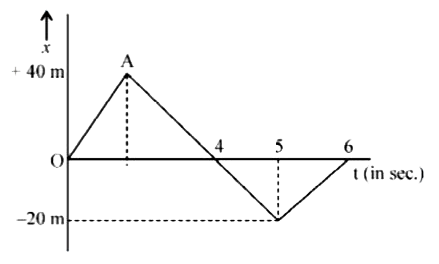The velocity of a particle increases from u to v in a time t during which it covers a distances S. If the particle has a uniform accerelation, which one of the following equations does not apply to the motion?
2S=(v+u)t
a=v−ut
v2=u2−2aS
S=(u+12at)t
The correct Answer is:C
To solve the problem, we need to identify which equation of motion does not apply to a particle moving with uniform acceleration, given that its velocity changes from u to v over a time t while covering a distance S.
1. Understanding the Variables:
- Initial velocity: u
- Final velocity: v
- Time taken: t
- Distance covered: S
- Uniform acceleration: a
2. Using the First Equation of Motion:
The first equation of motion relates final velocity, initial velocity, acceleration, and time:
v=u+at
From this, we can express acceleration as:
a=v−ut
3. Using the Second Equation of Motion:
The second equation of motion relates distance, initial velocity, time, and acceleration:
S=ut+12at2
Substituting a from the first equation into this gives:
S=ut+12(v−ut)t2
Simplifying this, we get:
S=ut+12(v−u)t
Rearranging yields:
2S=(u+v)t
4. Using the Third Equation of Motion:
The third equation of motion relates the velocities and distance:
v2=u2+2aS
Substituting a from the first equation gives:
v2=u2+2(v−ut)S
5. Identifying the Incorrect Equation:
The options provided include:
- v2=u2+2aS
- v2=u2−2S (This option is incorrect because it suggests a negative relationship which does not apply in this context)
- S=ut+12at2
- 2S=(u+v)t
The equation v2=u2−2S is not applicable because it does not correctly represent the relationship between the variables when acceleration is positive. The correct form should be v2=u2+2aS.
Conclusion:
The equation that does not apply to the motion is:
Option C: v2=u2−2S
- Initial velocity: u
- Final velocity: v
- Time taken: t
- Distance covered: S
- Uniform acceleration: a
The first equation of motion relates final velocity, initial velocity, acceleration, and time:
v=u+at
From this, we can express acceleration as:
a=v−ut
The second equation of motion relates distance, initial velocity, time, and acceleration:
S=ut+12at2
Substituting a from the first equation into this gives:
S=ut+12(v−ut)t2
Simplifying this, we get:
S=ut+12(v−u)t
Rearranging yields:
2S=(u+v)t
The third equation of motion relates the velocities and distance:
v2=u2+2aS
Substituting a from the first equation gives:
v2=u2+2(v−ut)S
The options provided include:
- v2=u2+2aS
- v2=u2−2S (This option is incorrect because it suggests a negative relationship which does not apply in this context)
- S=ut+12at2
- 2S=(u+v)t
The equation that does not apply to the motion is:
Option C: v2=u2−2S
Topper's Solved these Questions
- BOOK - MCGROW HILL PUBLICATIONCHAPTER - MOTIONEXERCISE - HIGHER ORDER THINKING QUESTIONS48videos
MOTION
- BOOK - MCGROW HILL PUBLICATIONCHAPTER - MISCELLANEOUS QUESTIONSEXERCISE - PART-B99videos
MISCELLANEOUS QUESTIONS
- BOOK - MCGROW HILL PUBLICATIONCHAPTER - REFLECTION OF LIGHT EXERCISE - HIGHER ORDER THINKING QUESTIONS10videos
REFLECTION OF LIGHT
Similar Questions
Knowledge Check
- Question 1 - Select One
A particle moves with uniform velocity. Which of the following statements about the motion of the particle is true?
AIts speed is.zeroBIts acceleration is zeroCIts acceleration is opposite to the velocityDIts speed may be variable. - Question 2 - Select One
A particle moves with a uniform velocity. Which of the following statements about the motion of particle is correct ?
AIts acceleration is zeroBIts speed is zeroCIts speed may be variableDIts acceleration is opposite to the velocity - Question 3 - Select One
A particle is moving an a uniform circular motion with radius 'r' Then the distance covered by the particle on one revoution will be
A2πrB2πCπrDπr2
A particle is constrained to move on a straight line path. It returns to the starting point after 10 sec . The total distance covered by the particle during this time is 30 m . Which of the following statements about the motion of the particle is false
View SolutionA particle exectuing simple harmonic motion of time period T has x V and as its displacement , velocity and ecceleration , rexpectively . Which of the following quantities does not change with time ?
View SolutionThe acceleratin of a particle increases linearly with time t as 6t. If the initial velocity of the particles is zero and the particle starts from the origin, then the distance traveled by the particle in time t will be
View SolutionA particle is forced to meove on a straight line path. It returns to the starting point after 10seconds.The→taldistancecoveredbythepartic≤dur∈gthistimeis 20 m. Which of the foolowing statements are true regarting the motion of the particles .
View SolutionIf x,v and a denote the displacement, the velocity and the acceleration of a particle executing simple harmonic motion of time period T, then, which of the following does not change with time ?
View Solution


